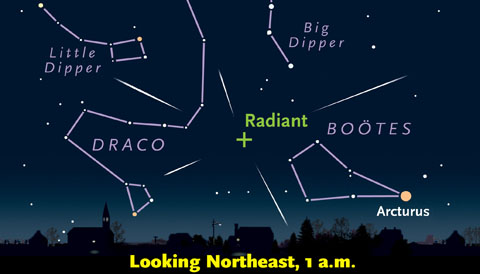The Quadrantid meteor shower is usually one of the year's best. But this year's event will be spoiled by strong light from an intruding Moon.
The year opens with a whimper as far as meteor showers are concerned, with less than optimal viewing conditions for the annual Quadrantids. Typically, this shower’s zenithal hourly rate (the idealized number of meteors visible when the radiant is at the zenith in a super-dark sky with a limiting magnitude of 6.5) reaches as high as 100, but this ideal output is balanced by a very narrow window for peak activity.
For 2018, this translates to a washout, or at least a “Moon-out.” The predicted peak for the Quadrantids falls early on the evening of January 3rd in North America, putting the shower in direct competition with light from a quite fat (94%-lit) waning gibbous Moon. Some of the shower's brightest arrivals should still show through the strong moonlight, but the usual counts will be greatly reduced.

Sky & Telescope diagram
This shower gets its name from Quadrans Muralis, the Mural Quadrant, a no-longer-used constellation situated in a dim region of the far-northern sky about halfway from the end of the Big Dipper’s handle to the head of Draco. If you watch this shower's meteors and trace their paths backward, the trajectories would appear to meet from this location (known as the radiant).
Unlike most annual meteor showers, the "Quads" don't originate from an active comet. Instead, their source is an asteroid designated 2003 EH1. Dynamicists suspect it is a dead chunk of a comet that broke apart several centuries ago, and that the meteors are small bits of debris from this fragmentation. Meteor specialist Peter Jenniskens (NASA Ames Research Center) was the first to link the orbits of 2003 EH1 and that of this strong meteor shower.
The high declination of the Quadrantid radiant (about +50°) is a boon for northern observers, because it remains above the horizon virtually all night. But actually this shower isn't very well documented — likely because because the peak is so brief, and because the shower arrives at the coldest time of night during the coldest part of winter. Some veteran observers strongly suspect that the Quadrantids vary a lot from one year to the next, but this might just be a fluke due to the relatively paucity of reports.
You still might want to spend a little time in search of the Quads. After all, there won't be another decent meteor shower until late April, when the Lyrids come to visit. Next year the Quadrantids' prospects are much better, because the Moon will be nearly new and nowhere to be seen in the nighttime sky.
 0
0
Comments
You must be logged in to post a comment.